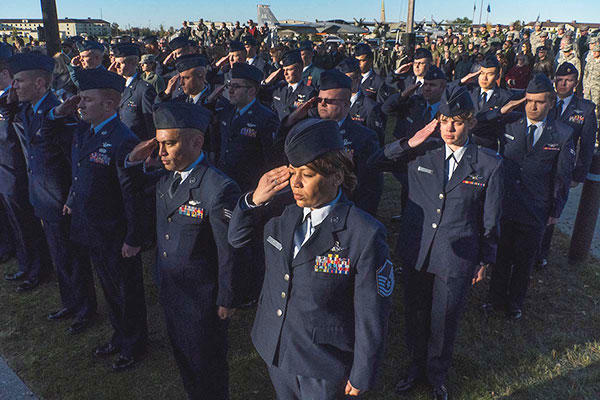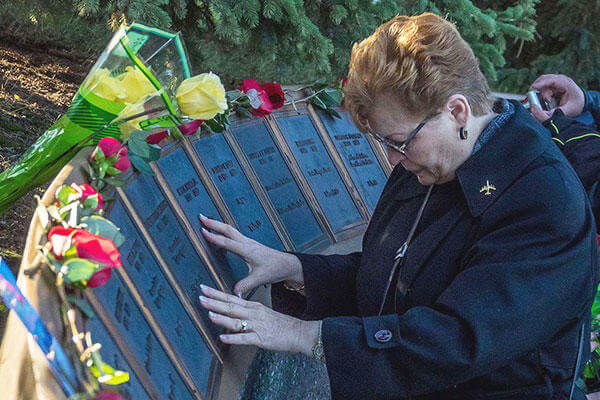JOINT BASE ELMENDORF-RICHARDSON, Alaska — Friday, Sept. 22, 1995, started out peaceful. Overcast skies were giving way to the heat of the sun, taking with them the last testimony of rain from the night before. Scattered clouds ranged from 5,000 to 20,000 feet, and visibility was 15 miles.
For Elmendorf Air Force Base flight line personnel, it was to be a light work day. The F-15 Eagle squadrons had water-survival training, and the 517th Airlift Squadron had several aircraft on rotation to Japan.
Regional flooding in the Kenai Peninsula dominated the state headlines, accounting for an estimated $5 million in combined private and public damages.
Somewhere on the flight line, crew members of E-3 Sentry Airborne Warning and Control System (AWACS) 77-0354, call sign "Yukla 27," methodically completed their pre-flight checklist.
After the essential checks, the tower gave approval for launch.
"Yukla Two-Seven Heavy clear for takeoff, runway five," Capt. Glenn Rogers said over the crackling radio.
"Clear for takeoff, crew," came the tower's response.
At 7:46 a.m., Yukla 27 rolled down runway five, the din of its four TF-33-PW-100 turbofan engines piercing the calm morning air as it began a routine reconnaissance flight.
A flock of about 30 Canada geese had been on the flight line, and just as Yukla 27 left the runway, so did the geese.
"Lot of birds here, we took one, we took two of them!" Rogers said over the radio. "Elmendorf tower, Yukla Two-Seven Heavy has an emergency."
Despite the severity of their situation, Yukla 27's crew began their emergency procedures with practiced professionalism.
"Lost No. 2 engine, we've taken some birds," Rogers announced as Canada geese were sucked into the aircraft's engines.
"Start dumping fuel."
"Start dumping," a different crew member responded.
Rogers grappled with physics, attempting to control the aircraft well below its stall speed.
"Yukla Two-Seven Heavy, roger, say intentions," the tower radioed back to the crew — a different voice this time.
"Yukla Two-Seven Heavy coming back around for an emergency return."
But Yukla 27 only made it about 270 feet into the air before vanishing into the birch forest 3,500 yards northeast of the flight line.
It was 7:47 a.m.
"We're going down," Rogers radioed his last transmission. "Two-Seven Heavy, emergency."
On its tragic 14,058th hour of flight, the 18th E-3 manufactured at the Renton, Washington, factory became the first sentry to fall in the line of duty.
Its 24 crew members, including two Canadian armed forces personnel, all perished.
Families and community members saw a mushroom of black smoke above an orange fireball from miles away, as roughly 125,000 pounds of JP-8 jet fuel exploded, immediately destroying the aircraft.
In a matter of 42 seconds, the peaceful Friday morning turned into a nightmare, which still haunts families and the community decades later.
On Sept. 22, 2015 — 20 years after Yukla 27's final flight — more than 150 friends and family members gathered in a frigid Alaska morning, having flown in from all over the world to honor the 24 crew members lost that day.
The current 962nd Airborne Air Control Squadron stood in formation in full service dress honoring the professionalism of those who came before them.
"It was a day much like this, the only flying that day was the AWACS because the jets had finished flying," then-Chief Master Sgt. Tracy Matthews, the superintendent in charge of maintenance for the 3rd Operations Group at the time, said at the memorial service.
"The aircraft took off, but as soon as you heard it go down the runway, you knew something was wrong. I had the corner window right there," Matthews said as he gestured to the south side of the 3rd Operations Group headquarters building. "I ran to the other side of the building. You could see the smoke. From that point on I knew we were dealing with tragedy."
Matthews now works as an emergency planner in disaster management for the Federal Aviation Administration. He said he still wonders how much Yukla had to do with his civilian career path.
Third Wing hosted the memorial service at the Yukla 27 monument outside the 3rd Operations Squadron headquarters building. The service was followed by a private ceremony at the site of the crash exclusively for family members and ended with a reception in Hangar 1 where family and friends of crewmembers could meet with each other.
"Over the past few years, I've had several conversations with members of the community who have expressed their thoughts, memories and emotions about that day: September 22, 1995," said Lt. Col. Erik Gonzalez, the 962nd AACS commander. "I've come to realize Yukla 27 is indelibly wrapped into the fabric of the Anchorage community, the Joint Base Elmendorf-Richardson community and larger Alaska history."
Gonzalez was the first of many guest speakers at the memorial, and he shared how the crash affected him as a young lieutenant.
"In 1999, as a newly minted lieutenant, I arrived at the 962nd," Gonzalez said at the ceremony. "Some of the more seasoned pilots in the squadron took me out to the crash site my first September in Alaska, where we offered a toast to fallen aviators. In that moment, the idea of fraternity became a salient one. In that moment I experienced a bond with men I had never met. In that moment, I understood what it meant to walk on hallowed ground."
After Gonzalez opened the event, several speakers came forth, one of whom was Kerry Long, an Alaska-region administrator for the FAA.
"We celebrate the 22 American and two Canadian aviators who sacrificed their lives upon the altar of freedom as crewmembers of Yukla 27," Long said.
Long explained how, after leaving the runway, jets are instructed to proceed to a point roughly 15 miles in the air created by the FAA. This point for Yukla 27 was known as the AWACS fix.
"The FAA is renaming the AWACS fix to the Yukla fix," Long said. "From now on, when an AWACS jet uses the Yukla departure and fix, her crew, the controllers, and all of us will be reminded of these 24 warriors."
After the guest speakers expressed their condolences for the families gathered in front of them, and they recalled how the tragedy has shaped them in some way over the past 20 years, the narrator announced the names of each fallen crew member.
As the names were called out, a current member of the 962nd AACS placed a flower on the individual memorial of a fallen crew member and rendered a salute.
Nothing disturbed the reverence of the moment. Other than the muffled sniffles of the family members and the occasional click of a camera, the entire ceremony was wrapped in silence.
Then, every military member present rendered a sharp salute, and the silence was broken by the mournful cry of bagpipes playing taps. An E-3 flew over the gathered mourners.
The significance of this wasn't lost on the family members who traveled thousands of miles for the observance.
"My brother was Steven Tuttle," said Deanne Frank, who took time off work and traveled from Fredericksburg, Virginia. "I'm the middle child out of the family, Steven was the oldest, I'm one of five — four remaining. We came up for the 10-year memorial and, at that time, there had been questions about whether the squadron would continue, so for us it's been nice knowing they haven't been forgotten."
Mike Miranda, from Old Town, Idaho, visited for the first time since 1995 to honor his youngest brother, Stephen O'Connell.
"It's important, everybody suffers in different ways," Miranda said. "It's important to be here. I'd like to see it happen as often as possible."
In his speech to the crowd, Col. Jay Bickley, vice commander of the 12th Air Force and former E-3 Sentry aircraft commander, said Yukla 27 was one of the top 10 percent of aircraft investigations where no fault was found in the crew.
It is now standard procedure for E-3 pilots to fly the Yukla 27 scenario in the simulators, not to see what could be done differently, but to see that even when a crew does everything right, everything can go wrong.
The Bird Aircraft Strike Hazard program was also heavily modified and passed into the hands of the U.S. Department of Agriculture.
"Everyone who has a history with AWACS will know exactly where they were when they heard the words of Yukla going down," Bickley said. "It impacted the community in ways we'll never really know. It made us more aware, it made us better, it made us do things differently to try and avoid such a tragedy from ever happening again."
Yukla 27 crew
First Lt. Carlos A. Arriaga, weapons director
Tech. Sgt. Mark A. Bramer, flight engineer
Staff Sgt. Scott A. Bresson, airborne radar technician
Tech. Sgt. Mark A. Collins, communications systems operator
Senior Airman Lawrence E. DeFrancesco, communications systems operator
Tech. Sgt. Bart L. Holmes Sr., flight engineer
Lt. Col. Richard G. Leary, navigator
Master Cpl. Joseph J.P. Legault, Canadian forces, communications technician
Capt. Robert J. Long, senior weapons director
Master Sgt. Stephen C. O'Connell, advanced airborne surveillance technician
Capt. Bradley W. Paakola, co-pilot
Tech. Sgt. Ernest R. Parrish, area specialist
Sgt. David L. Pitcher, Canadian Forces, battle director technician
Capt. Glenn "Skip" Rogers Jr., aircraft commander
Airman Jeshua C. Smith, airborne surveillance technician
Staff Sgt. Raymond O. Spencer Jr., airborne surveillance technician
Maj. Richard P. Stewart II, mission crew commander
Tech. Sgt. Charles D. Sweet Jr., airborne radar technician
Maj. Marlon R. Thomas, mission crew commander
Tech. Sgt. Timothy B. Thomas, computer display maintenance technician
Maj. Steven A. Tuttle, airborne surveillance officer
Tech. Sgt. Brian K. Van Leer, advanced airborne surveillance technician
Airman Darien F. Watson, airborne surveillance technician
Senior Airman Joshua N. Weter, computer display maintenance technician




























